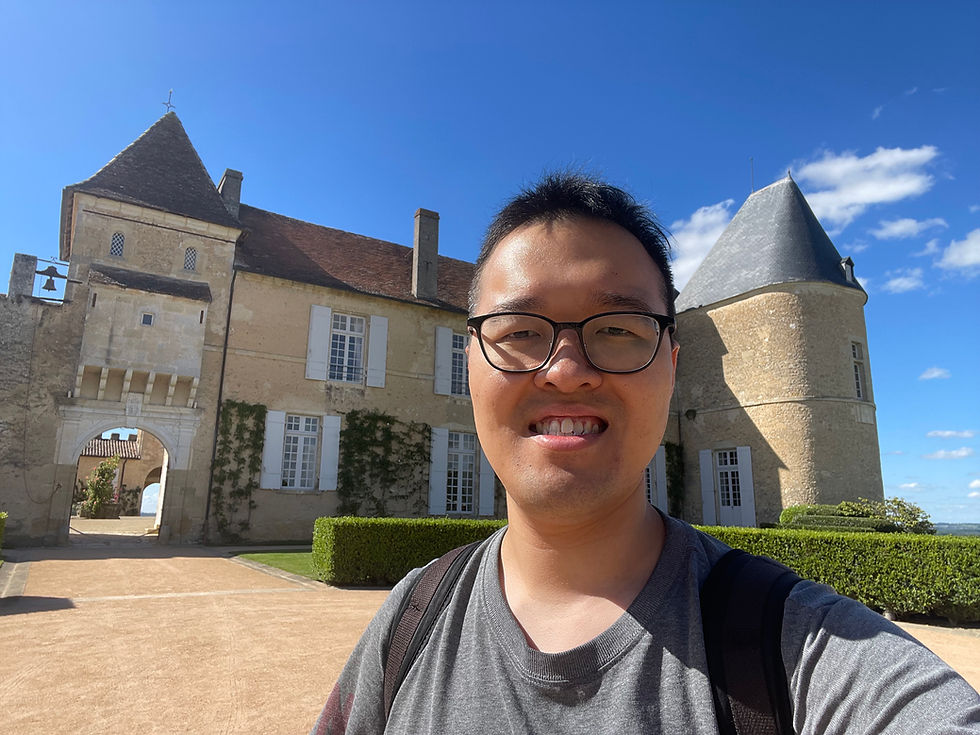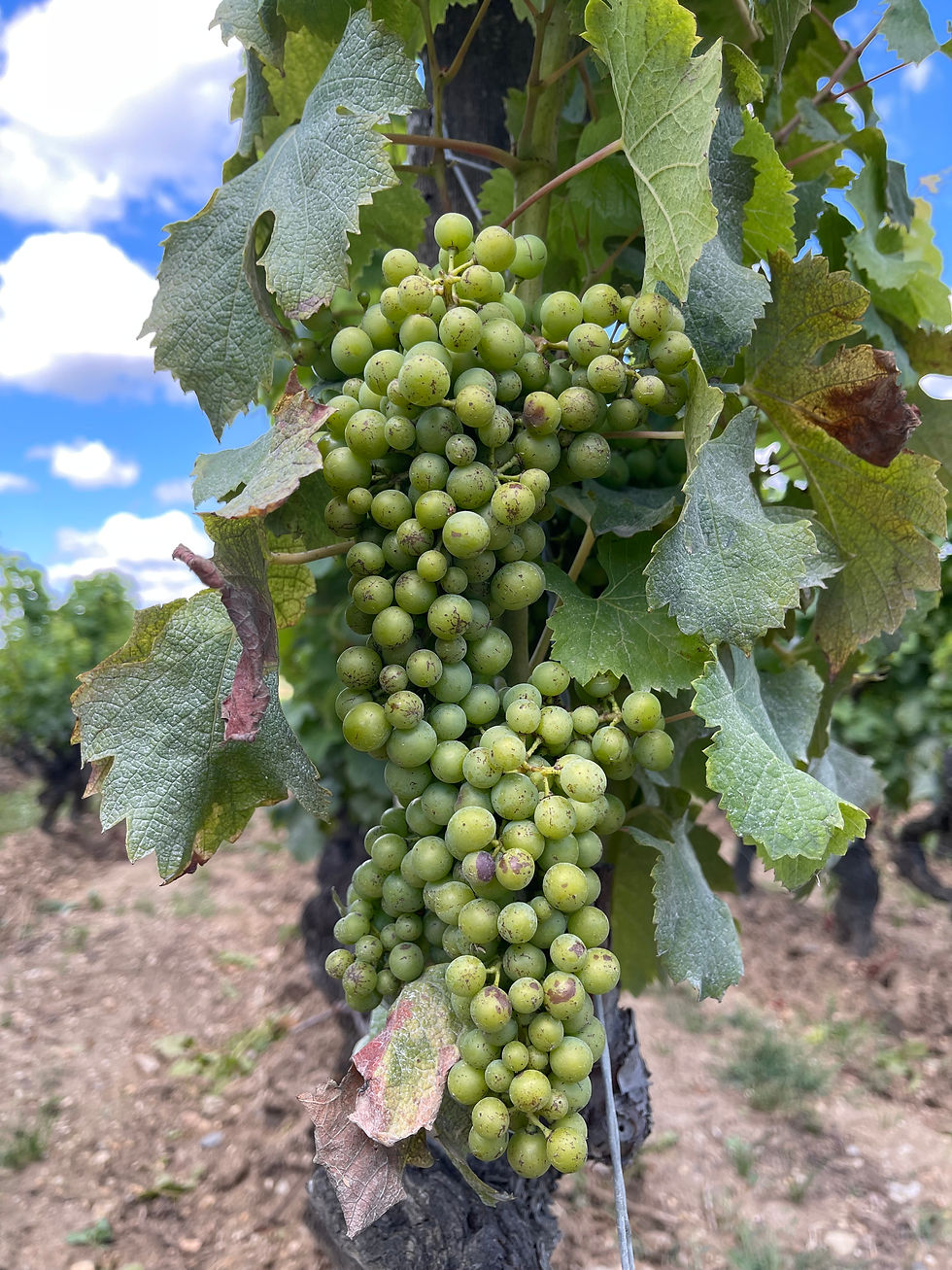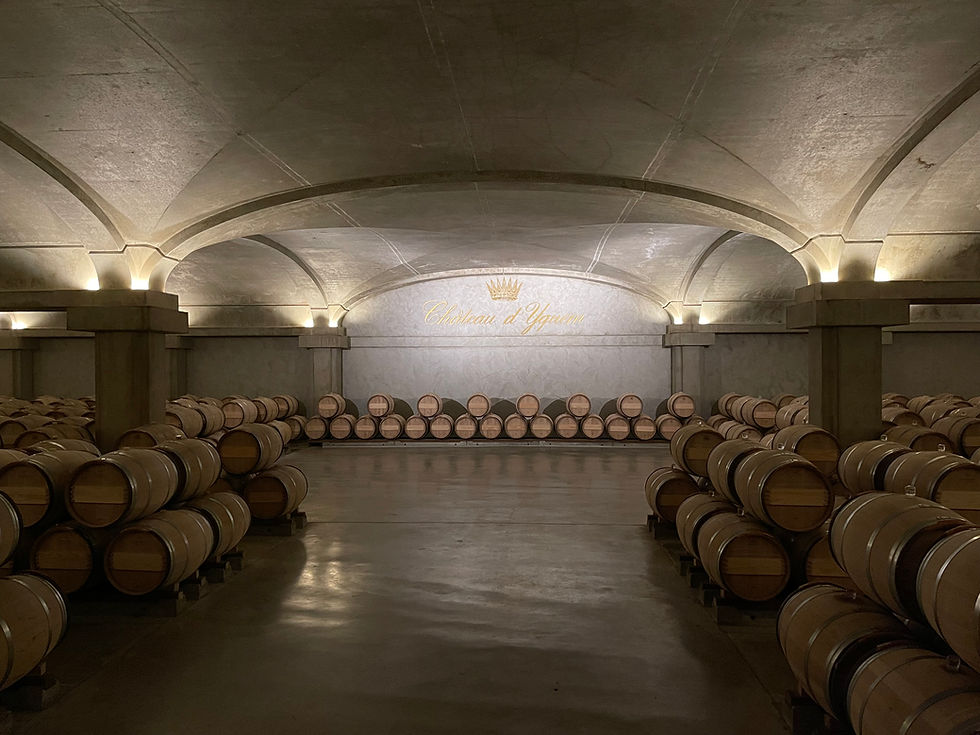Château d’Yquem – Dive into the Enigmatic Elegance to Experience the Magic
- Song Wei

- Jul 16, 2024
- 8 min read
Updated: Feb 10, 2025
It was a Friday – the 12th of July 2024. I had just sat for my DipWSET D1 exam on wine production. The exam was a grueling marathon of relentless and exhaustive knowledge testing. It left me mentally parched when it finally ended, leaving me in dire need of a cognitive refreshment. This was the time when one of my course mates popped up the idea of visiting Château d’Yquem and invited me to join. Without any second thought, I said yes.
Close to an hour of car ride later, we entered the gates of Château d’Yquem. As I approached the storied grounds of Château d'Yquem for the first time, the excitement was almost palpable. The sun-drenched vineyards stretched endlessly, whispering promises of the liquid gold they would yield. Nestled in the heart of Bordeaux's Sauternes region, Château d'Yquem is a name synonymous with history, opulence, and a touch of enigma. After all, it is the one and only Château that obtained the distinction of Premier Cru Supérieur (French for Superior First Growth) during the 1855 Classification of Bordeaux wines at the request of Napoléon III for the Paris World's Fair.



The visit began with a guided tour of the vineyards, where the meticulous care given to each vine was evident. Sprawling rows of meticulously maintained grapevines stretched out before us; each one pruned and nurtured with an almost obsessive attention to detail. The guide, a passionate oenologist, led us through the verdant expanse, explaining the unique terroir of Château d'Yquem. This region of Sauternes enjoys a microclimate that is crucial for the development of the noble rot, Botrytis cinerea, which is essential to the creation of their legendary wine.
Château d'Yquem is perched on the highest hill in the Sauternes region, with its vineyards sprawling across a varied landscape. This elevated position offers several advantages, including excellent drainage and exposure to sunlight. One of the most notable benefits is the exposure to strong winds that sweep up the hill. This is one of the many unique features that makes Château d'Yquem the only estate in the Sauternes region to enjoy this gift of nature. The strong winds enhance airflow and ventilation throughout the vineyard. They help to regulate the microclimate to create optimal conditions for the controlled development of noble rot. The interplay between the morning mists created from the mingling of the cool waters of Ciron river with the warm waters of the Garonne river and the drying afternoon winds creates a perfect balance of humidity and dryness. The morning mists provide the necessary moisture for Botrytis cinerea to infect the grapes, while the afternoon winds dry the grape, preventing the excessive moisture that grey rot thrives on, thus allowing for the slow, controlled concentration of sugars and flavors that define Château d'Yquem wines.
The soil at Château d'Yquem is a complex mosaic that plays a crucial role in the wine's quality. It is primarily composed of 4 types of soils, namely gravel, clay, sand, and limestone. The topsoil is warm and dry, accumulating heat thanks to smooth flat pebbles and coarse gravel. The clay subsoil contains good water reserves and there are numerous springs on the estate. It has 113 hectares of vines planted on a very representative sampling of the rich tapestry of the Sauternes region's soil types. This extraordinary variety of soils is a key factor in the quality and complexity of Château d’Yquem.

The vineyard of Château d’Yquem is planted with only two grape varieties – Sémillon and Sauvignon Blanc. Sémillon, which accounts for 75% of the total vineyard plantings, produces a rich wine with body and structure, whereas Sauvignon Blanc, which represented 25% of total vineyard plantings, is an early-ripening but less reliable producer that contributes aromas and finesse. The vines are tended with the greatest of care. Each specific plot of vines is assigned to a female vineyard worker, whose unique touch and expertise become evident through their distinctive pruning methods. The individual pruning styles of the vineyard workers become a signature of their craftsmanship, recognizable to the trained eye. This individualised stewardship allows the workers to develop an intimate understanding of their designated vines, from their growth patterns and health to their specific needs throughout the season. This personalised approach highlights the deep connection between the workers and the land, contributing to the unparalleled quality and reputation of Château d'Yquem wines.




Among its 113 hectares of vines, only one hundred produce grapes in a given vintage. Two to three hectares of vines that are too old are uprooted annually, and the soil left fallow for a year. Furthermore, it takes at least 5 years before new vines produce grapes that are up to Château d’Yquem’s very strict standards. Twelve hectares of vines are thus non-productive every year. Château d’Yquem also maintains a unique “library” plot of vines. This plot is a testament to their commitment to preserving and enhancing the genetic diversity and quality of their vineyards through the practice of sélection massale. Only the best-performing vines with the highest quality traits are selected and marked for future propagation. This plot is essentially a living repository of vine varieties, showcasing the estate's dedication to heritage, sustainability, and excellence in winemaking.
Furthermore, Château d'Yquem utilises pheromone tags in its vineyards as a sustainable pest management strategy. These tags release specific pheromones that disrupt the mating patterns of pests, which are harmful to grape crops. By interfering with the pests' ability to reproduce, the population of these insects is significantly reduced. This method helps minimise the reliance on chemical pesticides, promoting a healthier ecosystem and producing wine in an environmentally friendly manner. The use of pheromone tags aligns with Château d'Yquem's commitment to sustainability and preserving the natural balance of their vineyards.

After a stroll around the historic vineyards, our guide led us into the cellar ‒ a magical place where the art and science of transforming grapes into wine truly come to life. Unusually in Sauternes, fermentation at Château d’Yquem takes place in barrel to maintain maximum control over this most delicate and mysterious part of winemaking. Only new barrels are used each year. These are made with the finest stave oak from forests in the eastern part of central France. At the time of writing, each barrel costs approximately €900. Each individual barrel is closely monitored, and the château's in-house laboratory carries out regular analyses. The most active musts finish fermenting in just two weeks. However, others can take up to six weeks. Fermentation stops naturally in all instances. A preliminary blend is made from selected batches in the spring following the harvest. After taste tests and laboratory analyses, wines not up to the château's strict standards are set aside. The barrels that have been retained are then moved to the ageing cellar where they will stay for twenty months. Every barrel is topped up twice a week. This consists of adding wine to fill up the airspace created by evaporation at the top of the barrel. Furthermore, every barrel is racked fifteen times to remove heavy lees. Light sediment in suspension is removed by a process called fining. The rigorous selection process continues in the cellar. Towards the end of barrel ageing, a rigorous selection takes place at blind tastings. This will determine the final blend of Château d’Yquem.




Our guided tour culminated in the highly anticipated tasting session. This session featured a glass of the Château d'Yquem 2017 vintage. The 2017 vintage was characterised by its rich, golden color, and an aromatic bouquet of tropical fruits, honey, and floral notes. On the palate, it delivered a harmonious blend of sweetness and acidity, with a long, luxurious finish. Although the 2017 vintage seemed young, it exemplified the epitome of sweet white winemaking. The Château d'Yquem 2017 vintage sat right at the centre of the tasting square, balancing between sweetness, acidity, flavour concentration and alcohol. None of the components was overwhelming that could potentially mask the attributes of others.



We were blessed when our guide offered us to taste the Château d'Yquem 2009 vintage. It gave a deep golden hue and an intense bouquet of honey, apricot, tropical fruits, and a hint of vanilla. On the palate, it was lush and viscous, with a harmonious balance of sweetness and acidity, giving a long, complex finish that lingered with apparent notes of caramel and spice. While both vintages exhibited the hallmark finesse of Château d'Yquem, the 2009 vintage offered a more mature, decadent experience, whereas the 2017 captivated with its youthful exuberance and clarity.


Drinking a young Château d'Yquem often evokes disbelief and disapproval among wine connoisseurs, as this esteemed Sauternes is traditionally revered for its ageing potential. Many believe that its true complexity and depth only fully emerge after years, if not decades, in the bottle. In my humble opinion, I strongly disagree and refuse to conform myself to such notion. Wines of Château d'Yquem are not better with age; they are simply different! Each vintage of Château d'Yquem offers a unique experience and showcases distinct nuances, regardless of its age. A young Château d'Yquem presents fresher, more vibrant fruit flavours and a livelier acidity, while an older vintage develops richer, more layered, and more intricate characteristics. Thus, every bottle, whether young or aged, provides a singular and valuable tasting experience, reflecting the diversity and complexity of this iconic wine. It is akin to a meditative journey, allowing one to appreciate each subtle nuance and transformation in the glass. The wine’s luxurious texture, balance of sweetness and acidity, and long, evolving finish provide a captivating sensory experience that encourages thoughtful reflection and quiet enjoyment, especially when one is tasting this meditation wine in the serene setting of Château d'Yquem.
It is an understatement to label Château d'Yquem wines as dessert wines; they transcend this narrow categorisation. While its sweetness makes it a natural pairing for desserts, its versatility and complexity allow it to shine in a variety of culinary contexts. The wine's balanced acidity and rich flavors complement savory dishes like foie gras, blue cheese, and even certain seafood and poultry preparations. Its ability to evolve and reveal new nuances over time makes wines from Château d'Yquem suitable for any occasion, from celebratory to contemplative, and a match for meals across the spectrum, far beyond the confines of dessert. I would very much like to pair wines from Château d'Yquem with freshly shucked half-shell oysters from the Arcachon Bay!








Comments